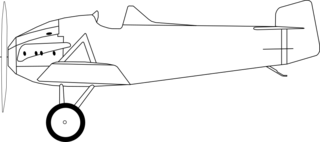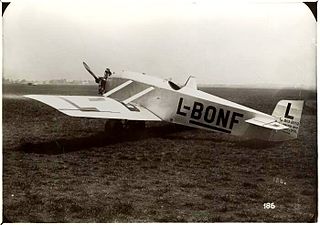
The Avia BH-1 was a two-seat sports plane built in Czechoslovakia in 1920. It was the first product of the Avia company, and it was originally designated BH-1 exp. The BH-1 was a low-wing braced monoplane of wooden construction, with tailskid undercarriage. Power was provided by a Daimler engine, which proved inadequate to fly the aircraft with both seats occupied.

The Avia BH-3 was a fighter plane built in Czechoslovakia in 1921. Conceptually a descendant of the BH-1 sports plane, it was a braced, low-wing monoplane of conventional configuration and tailskid undercarriage. Following favourable trials in June 1921, ten examples were ordered by the Czechoslovakian Air Force. These were delivered in 1923 under the military designation B.3. The type proved temperamental in service and was soon relegated to training duties, where it served until 1927.

The Avia BH-4 was a prototype fighter aircraft built in Czechoslovakia in 1922. It was a development of the BH-3 fitted with a Hispano-Suiza 8 engine in an attempt to improve the aircraft's performance. To accommodate the new powerplant, the forward fuselage was considerably redesigned, and the structure in general and undercarriage in particular were strengthened. Performance was found to be only marginally better than the BH-3, and development was quickly abandoned.

The Avia BH-5 was a two-seat sport aircraft built in Czechoslovakia in 1923. It was based on the firm's experience with the BH-1 and shared that aircraft's basic design: a low-wing, braced monoplane. As a result of its L-BOSA registration, all slow flying Avia monoplanes of the BH-5 lineage were nicknamed Boska. The BH-5 was flown competitively by Zdeněk Lhota at the Belgian Touring Aircraft Contest in Brussels in 1923, and won both the overall prize for the event and the King of Belgium Prize. The same year, it won the first prize in its class in the Czechoslovak President of the Republic Competition.

The Avia BH-6 was a prototype fighter aircraft built in Czechoslovakia in 1923. It was a single-bay biplane of unusual configuration, developed in tandem with the BH-7, which shared its fuselage and tail design.

The Avia BH-7 was a prototype fighter aircraft built in Czechoslovakia in 1923. It was a parasol-wing monoplane developed in tandem with, and as an alternative to the BH-6, which shared its fuselage and tail design. Like the BH-6, the BH-7 was involved in a number of serious crashes during its test programme, which led to its abandonment as a fighter. Undaunted, however, Avia used the design as the basis for a racing aircraft, shortening the wingspan by 1.4 m, fairing the wing directly onto the top of the fuselage and dispensing with the cabane struts. This revised version was designated BH-7B and the fighter (retrospectively) as the BH-7A. When the design proved no more successful as a racer, it was finally put to rest.

The Avia BH-8 was a prototype fighter aircraft built in Czechoslovakia in 1923. It was an unequal-span biplane developed on the basis of the ill-fated BH-6 design, in an attempt to address that type's problems. It shared the BH-6's unusual wing cellule design.

The Avia BH-9 was a twin-seat sports plane built in Czechoslovakia in 1923, based on the BH-5. As with other developments in the BH-1 lineage, the BH-9 was a low-wing braced monoplane that accommodated the pilot and passenger in tandem, open cockpits. The BH-9's structure was strengthened to allow the use of a higher-power engine than in its predecessors, and for the first time, this was a domestically-produced powerplant. Although built as a twin-seat aircraft at least one was converted to a single-seater.

The Avia BH-10 was a single-seat aerobatic sports plane built in Czechoslovakia in 1924, based on the Avia BH-9, which was in turn developed from the BH-5 and BH-1. It was easily visually distinguished from the BH-9 by the tall anti-roll pylon added behind the open cockpit in order to protect the pilot in the event that the aircraft flipped over or crashed while inverted. 21 copies of the aircraft were built, 10 of which were bought by the Czechoslovakian Army as a training aircraft and operated under the designation B.10.

The Avia BH-11 was a two-seat monoplane sport aircraft designed and produced by the Czechoslovakian aircraft manufacturer Avia.

The Avia BH-12 was a two-seat sport aircraft built in Czechoslovakia in 1924, the final development of the Avia BH-9 family that had its roots in Avia's first aircraft design, the BH-1. It was a low-wing, braced monoplane intended for sports flying, and featured a redesigned wing that could be folded to allow the aircraft to be towed by road. The wing pivoted around its spar and then folded back, flat against the fuselage sides.

The Avia BH-16 was a single-seat very light sport aircraft built in Czechoslovakia in 1924. Like other early Avia designs, it was a low-wing braced monoplane of wooden construction. It could be powered by either a 12 kW (16 hp) four-cylinder Vaslin engine or a 19 kW (26 hp) inverted-V twin-Blackburne Tomtit.

The Avia BH-17 was a biplane fighter aircraft built in Czechoslovakia in 1924. It was a development of the BH-6 and BH-8, and work on the latter aircraft was cut short in favour of this one. Operational trials in 1924 revealed performance good enough for the Czechoslovak Air Force to place an order for 24 examples. In actual service, however, the BH-17 proved unreliable and was soon withdrawn.
The Avia BH-19 was a fighter aircraft built in Czechoslovakia in 1924. It was a low-wing braced monoplane derived from the Avia BH-3 and reflected its designers' ongoing belief that the monoplane configuration was the most suitable for a fighter aircraft. Initial trials revealed excellent performance, but also displayed control problems and aileron flutter. Nevertheless, the Czechoslovakian Army was sufficiently impressed to inform Avia that it would order the BH-19 if the problems could be rectified. The first prototype was destroyed in a crash during speed trials, and the second prototype revealed no better handling than its predecessor. At this point, the Czechoslovakian War Ministry stepped in and asked Avia to cease its attempts to develop a monoplane fighter.
The Avia BH-20 was a civil trainer aircraft built in Czechoslovakia in 1924. It was a single-bay, unstaggered biplane of conventional configuration. The wings were braced with N-struts at around half-span. The pilot and instructor were seated in tandem, open cockpits.

The Avia BH-23 was a prototype night fighter aircraft built in Czechoslovakia in 1926. The design was derived from the BH-21 day fighter, incorporating structural changes made to the BH-22 trainer, and the type was originally designated BH-22N. Searchlights and other night-flying equipment were added, but the Czechoslovak Air Force were not interested in the project and no sale resulted.

The Avia BH-26 was a two-seat armed reconnaissance aircraft built in Czechoslovakia in 1927. It was a single-bay unstaggered biplane with equal-span wings and a fixed tailskid undercarriage. Both upper and lower wings featured long-span ailerons, which were dynamically balanced by a small auxiliary airfoil mounted to the upper surface of the lower ailerons. Its design was typical of this type of aircraft built during World War I and the years following; pilot and observer sat in tandem open cockpits with the observer armed with a machine gun on a ring mount. As with many other Avia designs, the BH-26 originally had no fixed fin, only a rudder, but this was changed in service.

The Avia BH-28 was a military reconnaissance biplane aircraft developed in Czechoslovakia in 1927 to meet a requirement for such an aircraft by the government of Romania. Avia based the design on their BH-26, but replaced the engine with an Armstrong Siddeley Jaguar, as specified in the requirement. The completed aircraft was taken to Bucharest for demonstration, but no order ensued, and this prototype was the only example constructed.

The Avia BH-29 was a trainer aircraft built in Czechoslovakia in 1927, in the hope of marketing it to both the Czechoslovakian Army, and to Czechoslovakian Airlines as a primary trainer. It was an conventional design, an unequal-span biplane of wooden construction and with tailskid undercarriage. The pilot and instructor sat in tandem open cockpits. A more powerful version was built, powered by a 120 hp (89 kW) Walter NZ-120 radial engine.

The Avia BH-33 was a biplane fighter aircraft built in Czechoslovakia in 1927. It was based on the BH-21J which demonstrated promising results by combining the original BH-21 airframe with a licence-built Bristol Jupiter radial engine. Other than the peculiar Avia hallmark of having an upper wing with a shorter span than the lower, it was utterly conventional, even featuring a tail fin for the first time in a Pavel Beneš and Miroslav Hajn design.



















